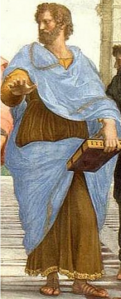Virtue Theory
- His definition of virtues divided them into two types: moral, which are shaped through early training and reinforced to become matter of habit, and intellectual,
 which can be rationally taught.
which can be rationally taught. - All virtues have the common structure of falling between two extremes at a point called the Golden Mean. Virtues are the mean between excess and deficiency.
- He believed that because every action and decision aims at some good, the good has been well described as that at which everything aims.
- A virtuous response or action is intermediate. For example, it is not good to feel angry too often, or too little, because then one can be taken advantage of.
- There are child prodigies in chess, math, and music, but never in morality, because moral knowledge comes not genetically, but only by experience.
- According to his virtue theory, philosophy should concern itself with defining conditions of flourishing, or eudaimonia, for humans.
Eudaimonia
- His concept of eudaimonia, which is sort of like human flourishing, is promoted by certain ways of living, just as certain ways of caring for a cherry tree will cause it to grow, blossom, and fruit.
- We are what we repeatedly do.
- According to his concept of eudaimonia, a tragedy toward the end of your life can potentially put a slant on whether your entire life as a whole went well. This implies the truth of the converse; that a wonderful event toward the end of your life can positively alter an otherwise bad one.
Ancient Science and Logic
- Begins with the conviction that our perceptual and cognitive faculties are basically dependable, that they for the most part put us into direct contact with the features and divisions of our world, and that we need not dally with skeptical postures before engaging in substantive philosophy. Accordingly, he proceeds in all areas of inquiry in the manner of a modern day natural scientist who takes it for granted that progress follows the assiduous application of a well trained mind, and so, when presented with a problem, simply goes to work.
- Aristotle saw logic as a tool that underlay knowledge of all kinds, and he undertook its study because he believed it to be a necessary first step for learning.
- Aristotle’s most important contribution to logic was the syllogism. A syllogism consists of certain assumptions or premises from which a conclusion can be deduced. Aristotle referred to the terms as the “extremes” and the “middle.” The middle term is the conclusion that links the two extremes. A traditional example runs as follows:
- All men are mortal.
- All Athenians are men.
- Therefore all Athenians are mortal.








Leave a comment